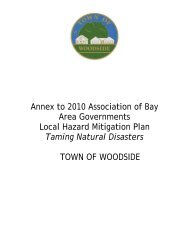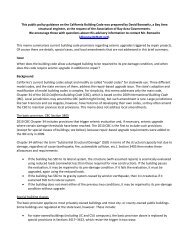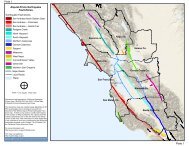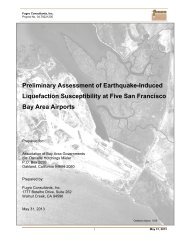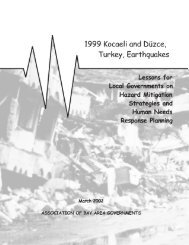Safe Enough to Stay - ABAG Earthquake and Hazards Program
Safe Enough to Stay - ABAG Earthquake and Hazards Program
Safe Enough to Stay - ABAG Earthquake and Hazards Program
- No tags were found...
You also want an ePaper? Increase the reach of your titles
YUMPU automatically turns print PDFs into web optimized ePapers that Google loves.
<strong>Safe</strong> <strong>Enough</strong> <strong>to</strong> <strong>Stay</strong>Section II:What engineering criteriashould be used <strong>to</strong> determinewhether a home has adequateshelter-in-place capacity?Seismic evaluation is not like a smog check. There is no law requiringan existing building <strong>to</strong> be evaluated every few years. Even when thebuilding code for new construction changes, new regulations arenot retroactive. Consequently, most San Francisco buildings, whilelegally occupied <strong>and</strong> quite safe in day-<strong>to</strong>-day conditions, do not meetthe current seismic codes for new buildings — <strong>and</strong> are not requiredor expected <strong>to</strong> do so. Only when a building undergoes a triggeringevent such as an addition, alteration, repair or change of occupancyis it likely that it will be evaluated for earthquake performance <strong>and</strong>,if highly deficient, subject <strong>to</strong> retrofit. There are some exceptions. SanFrancisco’s unreinforced masonry buildings have been subject <strong>to</strong>m<strong>and</strong>a<strong>to</strong>ry evaluation <strong>and</strong> retrofit since 1992. And many owners <strong>and</strong>tenants voluntarily evaluate their buildings, but this voluntary work istypically not required <strong>to</strong> meet any upgrade st<strong>and</strong>ard.Whether m<strong>and</strong>ated by ordinance or triggered by the building code,seismic evaluations in San Francisco use criteria based on structuralsafety alone. With few exceptions, the criteria consider only whetherthe building would threaten lives by collapsing or would suffersevere damage during an earthquake. The criteria do not requirean explicit consideration of whether a damaged building would besafe <strong>to</strong> reoccupy or how long it might have <strong>to</strong> remain vacant whileundergoing repairs.SPUR recognizes that San Francisco’s resilience requires more thanbasic safety during the earthquake. It requires that buildings remainhabitable <strong>and</strong> repairable so that occupants can shelter safely in themeven before repairs begin.To support the move <strong>to</strong> resilience-based earthquake planning, the cityshould revisit its existing structural-evaluation criteria. Specifically,the city needs <strong>to</strong> determine what shelter-in-place means from anengineering perspective <strong>and</strong> <strong>to</strong> develop criteria for analyzing now,before the earthquake, whether a building is likely <strong>to</strong> serve as shelterin-placehousing afterward. The purpose of this section is <strong>to</strong> discusswhat shelter-in-place capacity means in engineering terms <strong>and</strong> <strong>to</strong>outline the engineering criteria that building owners <strong>and</strong> policymakersmight adopt for pre-earthquake shelter-in-place evaluations.32 Comerio, Mary C., “Performance Engineering <strong>and</strong> Disaster Recovery,” inBracing Berkeley: A Guide <strong>to</strong> Seismic <strong>Safe</strong>ty on the UC Berkeley Campus(Pacific <strong>Earthquake</strong> Engineering Research Center, January 2006).The need for shelter-in-placecriteriaWhen <strong>and</strong> why would a shelter-in-place evaluation be done? Theshort answer is: in the same cases <strong>and</strong> for the same reasons thatsafety-based evaluations are done now. An overarching themeof SPUR’s Resilient City initiative is that planning <strong>and</strong> regula<strong>to</strong>rypriorities should shift from personal safety <strong>to</strong> community resilience.Thus, wherever current programs, regulations or ordinances callfor seismic evaluation or upgrade, that work should (or could) bebased on shelter-in-place capacity instead of on safety alone. If newprograms are put in place <strong>to</strong> improve citywide resilience, they woulduse shelter-in-place engineering criteria as well.Seismic work (i.e., evaluations <strong>and</strong> upgrades) can be classified asvoluntary, m<strong>and</strong>a<strong>to</strong>ry or triggered. Each type of project or programcould use shelter-in-place engineering criteria, as opposed <strong>to</strong>provisions that look solely at safety.The good news is that much voluntary work already prioritizesreoccupancy <strong>and</strong> recovery. UC Berkeley, for example, recognizedthat even if its buildings have been deemed safe, not being able <strong>to</strong>use them during repairs could jeopardize the university’s mission, soit adopted an earthquake recovery goal <strong>to</strong> limit closure <strong>to</strong> no morethan 30 days. 32 In the housing sec<strong>to</strong>r, however, voluntary work forshelter-in-place or recovery purposes is rare. Where it does occur,it is done without a commonly adopted st<strong>and</strong>ard <strong>and</strong> without thebenefit of plans that have been checked <strong>and</strong> approved by the buildingdepartment, because voluntary work falls outside the scope of mostbuilding regulations. Further, even if the city’s plan-checkers <strong>and</strong>inspec<strong>to</strong>rs were <strong>to</strong> certify voluntary work, they currently have nocriteria by which <strong>to</strong> judge a shelter-in-place evaluation or retrofit.While a shelter-in-place evaluation is in some ways a prediction of abuilding’s performance during <strong>and</strong> after an earthquake, it is important<strong>to</strong> recognize that actual post-earthquake reoccupancy will depend onthe nature of ownership <strong>and</strong> on individual owners’ or tenants’ choicesabout whether <strong>to</strong> stay or leave. In owner-occupied housing, theowner is more likely <strong>to</strong> <strong>to</strong>lerate (or waive liability for) certain damage,so reoccupancy is likely <strong>to</strong> happen sooner. But an owner of rentalhousing might not allow tenants <strong>to</strong> reoccupy the building if remainingdamage would increase the owner’s liability or if reoccupancy woulddelay building repairs or increase their cost. Rent control will also playa significant role in the choices made by both renters <strong>and</strong> owners.The evaluation criteria recommended here do not account for thesevariables. The best strategy for promoting reoccupancy might nothave much <strong>to</strong> do with engineering st<strong>and</strong>ards; we encourage the city<strong>to</strong> work with owners <strong>to</strong> incentivize quick reoccupancy through GoodSamaritan laws or otherwise waive liability or relocation penalties.22 SPUR Report > January 2012




